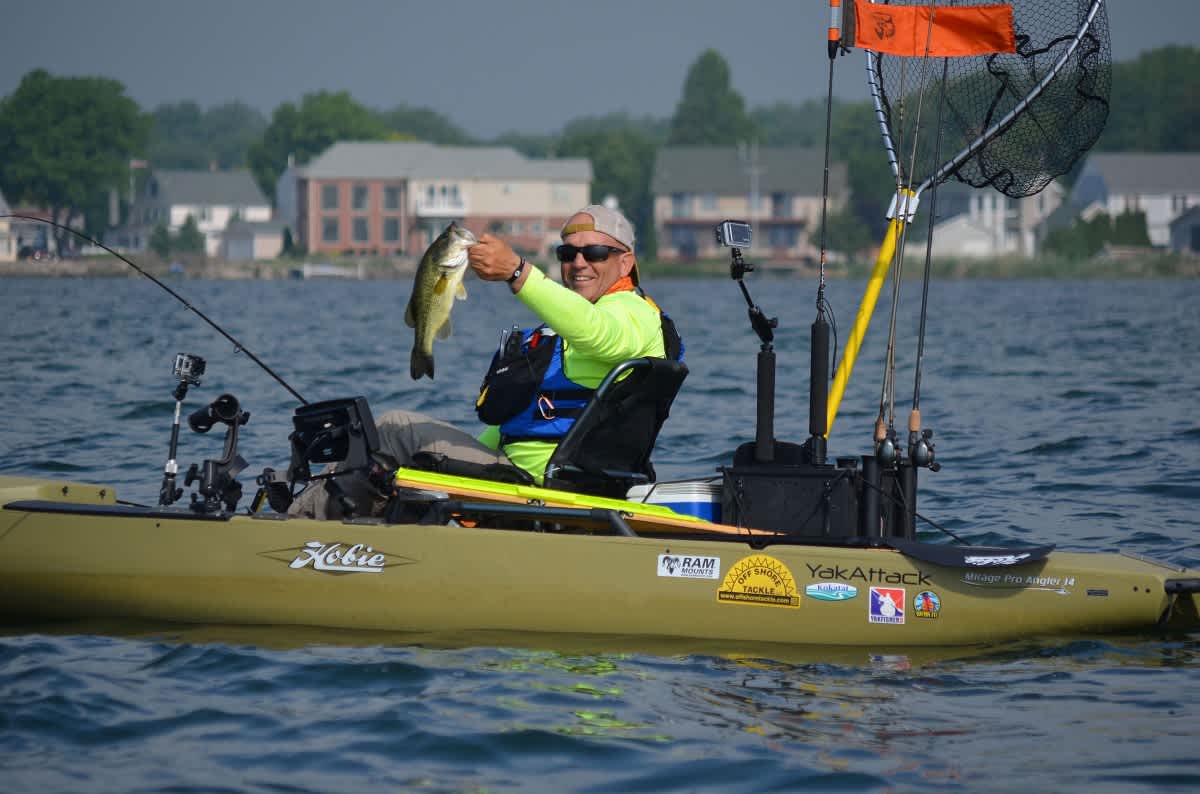Getting the Drift for Lake St. Clair Bass
Dave Mull 06.30.14

Not too many fishing holes exist where you can launch your kayak, buzz a little ways offshore, and catch a bunch of keeper bass in the space of four hours. Michigan’s 430-square-mile Lake St. Clair is one of them.
Bassmaster Magazine annually touts Lake St. Clair as one of the top bass fishing destinations in the country. Last year it was number one; this year it fell to 16. Nationally known for its big, plentiful smallmouth, it is loaded with largemouth, too.
Recently I met my fishing buddy Rich Ofner from Windsor, Ontario at St. Clair Metropark. We launched our 14-foot Hobie Pro Anglers, foot-pedal-propelled kayaks, at the jet-ski launch, which is on the main lake. An east wind blew towards shore, so we pedaled out and let the moderate breeze push us back towards land. We stayed close enough together to chat and take pictures of each other catching fish.

I had met Rich last year through Hobie connections—we’re both on the Hobie Fishing Team. Earlier this month, Rich had fished against 32 other kayakers on Kentucky Lake and finished third, and probably would have won the contest had a lunker not thrown the hook. A tool and die guy by trade, he only started fishing about six years ago after a long romance with hockey, both as a player and as a ref.
He’s a quick study when it comes to fishing, already having fished a Hobie World Championship in Australia and doing some other cool stuff—like landing a 60-inch sturgeon from the Michigan waters of the St. Clair River. That was last summer out of his 12-foot kayak.
The waters a mile or so from shore were still only six feet deep and weedy; perfect bass habitat. I started out casting tube jigs, spinnerbaits, and crankbaits with only the tube getting bites; one of them was a 10-inch Great Lakes strain muskie; a spotted, toothy denizen for which the lake is famous. As we fished, A-10 Warthog warplanes from nearby Selfridge Air Force Base roared around overhead, dipping in and out of the clouds. Small flocks of swans, nowhere near as loud but still clearly audible with whooshing, whistling wing beats, also provided aerial entertainment.
Rich scored regularly by simply drifting a tube he’d rigged weedless on a hook, a small split shot a couple feet in front to keep it easing across the weed tops. Blame it on lack of sleep from the three-hour drive from home that started at 4 a.m., but it took me a while to realize just how effective Rich’s drift technique was—he’d already caught three bass before I had my string stretched. My epiphany came when Rich caught a largemouth on the tube and placed his rod in the holder to pose for a picture. While holding the largemouth aloft for the camera, a much bigger smallmouth bass cleared the water by at least four feet, attached to Rich’s tube. There definitely was something to this drifting technique. After an impressive fight, he landed the fish and measured it at nearly 19 inches long. It ended up being our biggest fish of the morning.
The next time I pedaled out to start a drift, I rigged a Strike King KVD Caffeine Shad (a soft-plastic jerkbait), cast it out, and put the rod in a holder, just letting the wind do the work. Soon I was catching up to Rich’s tally, banging two quick largemouth and a nice smallie. All were better than the Michigan 14-inch minimum size to be a “keeper,” although we released each one and only kept some photographic evidence.
My biggest fish came while trolling back out to start another drift. I’d deployed a favorite panfish rig; two small Spin-N-Glos in front of a one-inch Berkley Pinched Crawler, hoping to catch one of the big bluegills Rich told me were in the area. The 18-inch smallmouth that bit the rig took about five minutes to land on the ultra-light spinning rod before exhausting itself. By about noon, with bunches of bass under our belts, the wind picked up and the sky let fly with heavy rain. We fished through it for a bit, but Rich checked a radar app on his cell phone and informed me a big storm was headed right at us. It was a trick to get the Hobies back on the landing as the shallow water turned into surf, but we got in without any real problems.
Lake St. Clair is truly a tremendous place to go fishing. Our weekday trip was the fifth time I’ve been on that big water, the first in a kayak, and the lake has never disappointed. I can’t wait to go back.
For more information on Michigan fishing go to michigan.org. Click here to purchase a Michigan fishing license online.
This article was produced in partnership with Pure Michigan.

